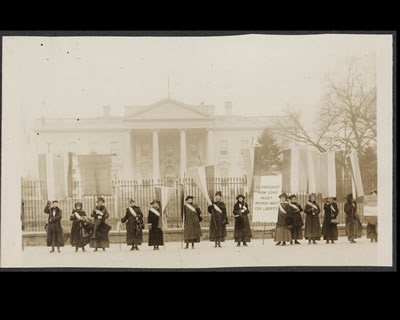The Barnum Museum at 820 Main Street in Bridgeport will present a talk entitled, “No More Pink Teas: The Militant Surge for Woman Suffrage,” on Sunday, March 25 from 2 to 3:30 p.m. The 1910s saw an increase in bold suffrage activity, from large parades held at State Capitols … such as the one in Hartford, Conn. to picketing at the White House, and holding “Watchfire for Freedom” protests. Connecticut, and Bridgeport in particular, were well represented in the struggle. Join Progressive-era suffrage historian Joanie DiMartino to discover how national and Connecticut suffragists participated in a surge of militant political activism that led to women gaining the right to vote in 1920. DiMartino is a poet, historian and a feminist. Work as a writer and as a museum professional allows her to offer connections between the scholarly historical record and contemporary audiences, in particular, the unique lives and perspectives of women throughout history. DiMartino supports the settled, the strong, and the strange. She does this by maintaining and sharing the artifacts and stories that are necessary and vital to people’s identity, and by presenting them in ways that are thought-provoking, engaging, and accessible, whether that medium is a poetry collection, a scholarly talk, a workshop, an article, a sermon or a series of innovative museum programs. In January 1918, President Wilson announced his support for the suffrage amendment, and the U.S. House of Representatives passed the proposed amendment. Despite support by prominent political leaders, including former President Theodore Roosevelt, conservative senators stood firm in their opposition to the extension of suffrage. The National Woman’s Party (NWP) redoubled their efforts to affect the vote in the Senate. In a lobbying attempt, the National Woman’s Party gathered signatures on a petition supporting passage of a suffrage amendment and delivered it to Senator Jones of New Mexico, Chairman of the Suffrage Committee. Of the 96 senators representing the 48 states in the union, 62 supported ratification in October, two votes short of the two-thirds majority needed to send the amendment to the states for ratification. Women who demonstrated outside the Senate Office Building were arrested. Forced to move from the gates outside the White House, the Watchfire activists moved across the street to Lafayette Square and continued their demonstrations , including burning presidential speeches, while Wilson was at the peace negotiations. The purpose of the Watchfire group was to demonstrate with women carrying banners and pickets, to show support of President Wilson’s encouragement for the women’s suffrage movement. Although President Wilson had expressed his support for the suffrage amendment, the NWP wanted him to be more active in urging passage of the amendment. President Wilson left Washington in December 1918 to attend the international peace conference in Versailles. In January 1919, the National Woman’s Party devised a new tactic to pressure for the adoption of a suffrage amendment to the Constitution. Members would gather with copies of the President’s speeches on issues relating to democracy and burn them in urns outside public buildings, including the White House. With a banner implying that the resident was a hypocrite, women outside the White House burned a speech Wilson had given on his grand tour of Europe. These “Watchfires of Freedom” resulted in more arrests and often provoked counter demonstrations. DiMartino has stated that if her work inspires or encourages others to visit museums, interview grandmothers, care for a family heirloom, write a poem, or start a journal, so much the better. She states, “We must write ourselves into the history of the future. Use your tools. Stain the page and spill ink.” This is an excellent talk to celebrate Women’s History Month, March. As a nod to the title, the afternoon’s activities will include light refreshments, with tea of course. This event is free to Barnum Museum members. However, seating is limited so reservations are required. To register, please visit Eventbrite. Interested parties may also contact by phone at 203-331-1104 x100. There is no donation required but a suggested donation of $7.50 per person. The event is free to all Museum Vision Members and children under 12. ABOUT THE BARNUM MUSEUM: Bridgeport’s Barnum Museum is one of P. T. Barnum’s many philanthropic gifts. Completed in 1893, the architecturally significant building boasts a unique combination of styles and terra cotta ornamentation, and is listed on the National Register. Today the museum proudly shares the history and legacy of the world-famous entrepreneur, showman, and museum proprietor, who was also a state legislator, mayor, real estate developer, and philanthropist. The museum is home to thousands of artifacts, many pertaining to Bridgeport native Tom Thumb and his wife, as well as the P. T. Barnum Family, and Nathaniel Wheeler Family. Their furniture, carriages, artwork and other items are currently displayed, along with a centaur and mermaid. Since 2010, the historic building has been undergoing repair and restoration due to a series of weather events that compromised the structure. The Museum’s Barnum World of Wonders Exhibit is currently open for visitors in the People’s United Bank Gallery located behind the historic building, open for viewing and tours from 11 a.m. to 3 p. on Thursdays and Fridays year round. The original Barnum Institute building is owned by the City of Bridgeport and is listed in the National Register of Historic Places.

